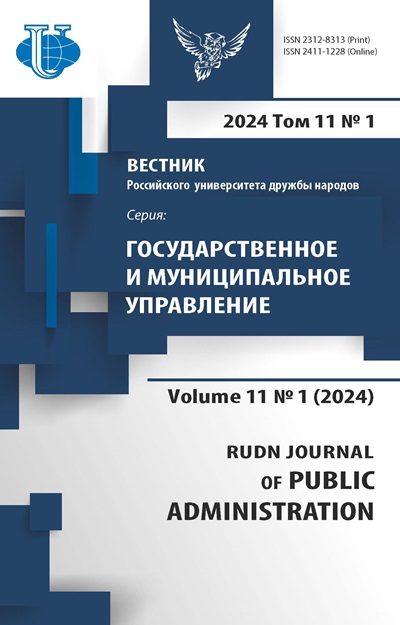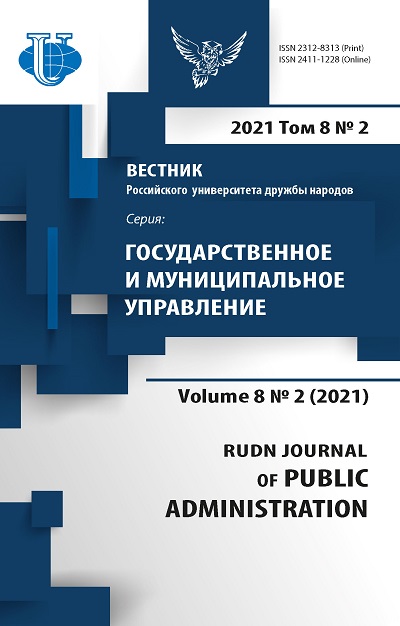How to Lead in Federal Government
- Authors: Alberstadt R.1, Scott J.1, Warwick D.2, Williams E.2, Kennedy T.2
-
Affiliations:
- United States Department of State
- United States Department of Defense
- Issue: Vol 8, No 2 (2021)
- Pages: 167-172
- Section: Public administration: theory and practice
- URL: https://journals.rudn.ru/public-administration/article/view/26438
- DOI: https://doi.org/10.22363/2312-8313-2021-8-2-167-172
Cite item
Full Text
Abstract
In today’s workplace, especially in the midst of today’s challenging times, we must understand the values of resilience, communication, decision-making, team-building, and diversity. These core competencies contribute to the success of being a diligent leader within government agencies. These competencies make the difference between opportunity and performance, and promote a positive work environment. Government agencies must make sure they are creating inclusive, diverse, and equitable workplaces.
Keywords
Full Text
Resilience Today’s challenges expose the necessity of developing a resilient workforce. Flexibility and communication are key ways to strengthen individual and shared resiliency. Leadership can demonstrate a genuine commitment to its best resource - its people - in accommodating flexible work schedules, such as telework and leave statuses, and protecting and expanding upon mental and physical health resources. Adopting preventative measures when possible, and reviewing policies along the way, establishes and communicates new procedures effectively and clearly. Effective communication entails providing timely and transparent information sharing when new information becomes available, as well as sharing an update of ‘no new information’, when applicable. Keeping people in the loop allows them ownership of the process and creates a dialogue, which engenders trust. Regular and effective communication enhances innovation and creativity by soliciting feedback from all levels of the workforce. Engaging with stakeholders lets them know their insight matters and that they are being heard. A resilient leader does not overcommit but welcomes opportunities to delegate and find ways to develop talented individuals to share the workload and appreciate their contribution. Emotionally intelligent leaders listen and lead with compassion and intuition. Building a resilient workforce means being intentional about accessibility and availability for feedback. Both soliciting feedback and resource sharing proves to be vital to morale and team-building efforts. Proactive leaders create a safe and supportive environment by fostering a creative and productive work environment where employees feel motivated and valued. Communication Communication is arguably one of the most crucial elements to improve all facets of life. We communicate to understand others, and to be understood. Without communication, we are ineffective in our ability to maintain personal relationships, close business deals, sell our potential when seeking a job or promotion, and to lead. The level of impact communication has is determined by our ability to use it. It is not just what we say, but how we say it; our eye contact and body language and the ability not just to speak but also to listen. Achieving a favorable result is determined by how we apply these strategies. Primarily, to be an effective communicator one must understand how to be a masterful listener without judgement or thinking about how to respond. When you do respond, you should not react but rather stay on point, and speak with clarity to avert misunderstanding. Additionally, maintaining eye contact will build your credibility and demonstrate sincerity to the listener. Strengthen self-confidence. Prepare yourself mentally, if necessary, and diminish all negative thoughts; a lack of self-confidence will be easily identifiable to your audience. Understand first impressions are everlasting; inherently, whatever the impression is they will not change their mind. What you say and what you do will not only affect yourself but will also affect the listener/audience and how they will perform. Their success will be determined by your ability to communicate with them. So, focus on how you can add value to them through your words, as they have the potential to serve a significant impact. Decision-Making Let’s face it: making a decision is often more stressful than the actual situation you are trying to resolve because of fear that any choice you make, will never make everyone happy. So, what is the best thing to do in order to decide the most effective outcome? In order to be an effective leader and make the best decision, know that people must trust your decisions. Do not allow your ego to over-shine your position so that you can never be wrong and unwilling to change perspective for the best decision. If time allows, re-review your decision again the next day and take the time to review the information based upon factual information. Ask for input and different views in order to get a better view from all angles, but never let someone else make the decision for you because as the leader, accountability falls upon your shoulders. Sometimes unpleasant facts stand in the way of a decision and the best way to address this is to develop your instincts. Instincts are honed from life experience. Beneficial experience comes from judgment, and superior judgment comes from dire experiences. When you are in a situation where there is little time, then those instincts are the best thing to rely upon. Know that you have to live with the consequences and choices you make so weigh your decision accordingly if it can be changed later or if it is permanent. Ultimately, once a decision is made, make sure to communicate it at all levels as early and directly as possible. Team-Building Physical fitness is a fundamental component of military life. It’s not only required for service members to stay fit, but can mean the difference between life and death. Service members must go beyond their basic Physical Training requirements in pursuit of fitness excellence. The COVID-19 pandemic has created challenges that have forced military personnel out of their training comfort zones and into a creative space to develop new exercise regimens to maintain their fitness. When the fitness facilities were first closed and classes were suspended, this created an opportunity for service members to take charge of their physical fitness in order to stay in shape without existing familiar structures. COVID-19 has rocked the fitness industry, resulting in administrative and financial disarray [1]. COVID-19 has also caused military facilities all across the country to discontinue group fitness classes and one-on-one personal training activities [2]. However, this created the opportunity for fitness leaders to “Lead without Authority” by expanding on team-building skills. By focusing on service, sharing, and caring by conducting group and physical training sessions virtually using Zoom, this allowed for effective team building efforts. Team building is strengthened by collaborating with team members to design and create fitness workouts that are safe, effective and motivational for military families. Additionally, fitness leaders have produced videos and coordinated with marketing departments to upload them to the Marine Corps Community Services websites [3]. While the pandemic negatively impacts the mental and social wellbeing of service members and their families, federal exercise programs provide a sense of normalcy and support. COVID-19 has inspired the spirit and driving force to lead, connect and build powerful effective teams with others using creative resources. Diversity In order to build effective teams, diversity needs to be a leveraged strategy. Diversity refers to a multitude of things including but not limited to race, ethnicity, and sex. According to the Office of Personnel Management (OPM) [4], a diverse workforce and an inclusive environment will improve performance and morale. Diversity requires continuous learning since it is more than working with individuals from different ethnic backgrounds. It is being inclusive and sensitive to their feelings, recognizing, and appreciating their differences. The underlying concept of diversity is acceptance and respect by acknowledging and celebrating an individual’s unique identity. In order to foster a diverse and inclusive workplace environment, an organization must make sure that they educate and train their leaders, since they will be instrumental in the organization’s inclusivity and diversity efforts. Organizations should dedicate time to celebrating diversity, such as Women’s History Month events, which could celebrate women in leadership roles. Along with diversity, it is important to enforce inclusion. Inclusivity is the acceptance of diversity and it is impossible to have one without the other. In today’s society, it is critical that organizations teach inclusion and advocate effective ways to practice inclusivity, particularly through diversity hiring and training. Federal leaders must build inclusive environments where all parties feel appreciated and recognized. During such uncertain times, it is imperative that organizations provide safe spaces for employees to discuss issues that are affecting them. Diversity and inclusion are central to having an effective work environment with high levels of productivity. It is the organization’s responsibility to create a strategic plan for fostering a diverse and inclusive environment in support of the organization’s mission and vision statement. Conclusion As we find ourselves adapting to leadership challenges in these turbulent times, it is important to communicate clearly and directly. Make sure to support diversity in the workplace and be as inclusive as possible. Make the best decisions you can and listen to your instincts. Be flexible to strengthen resilience anywhere you can in the workplace to help give resources that will improve mental and emotional situations. Even as we socially distance ourselves, team-building is still necessary and leaders should always find ways to stay connected. Stay safe.
About the authors
Rachel Alberstadt
United States Department of State
Author for correspondence.
Email: alberstadtra@gmail.com
ORCID iD: 0000-0001-7586-9059
Federal Employee of the Department of State, Participant of the New Leader Program with the Graduate School USA
2201 C Str. Northwest, Washington, D.C., U.SJesse Scott
United States Department of State
Email: jesse_scott@rocketmail.com
Federal Employee of the Department of State, Participant of the New Leader Program with the Graduate School USA
2201 C Str. Northwest, Washington, D.C., U.SDavid Warwick
United States Department of Defense
Email: warwickd65@hotmail.com
Federal Employee of the Department of Defense, Participant of the New Leader Program with the Graduate School USA
2 N, Rotary Rd., Arlington, VA, U.S. 22202Elizabeth Williams
United States Department of Defense
Email: epwilliams6@gmail.com
Federal Employee of the Department of Defense, Participant of the New Leader Program with the Graduate School USA
2 N, Rotary Rd., Arlington, VA, U.S. 22202Thomas Kennedy
United States Department of Defense
Email: 1kennedydanielle@gmail.com
Federal Employee of the Department of Defense, Participant of the New Leader Program with the Graduate School USA
2 N, Rotary Rd., Arlington, VA, U.S. 22202References
- How the Fitness Industry Is Responding to Coronavirus. Socialbakers. 2020. URL: https://www.socialbakers.com/blog/fitness-industry-takes-a-hit-from-covid. Accessed: 10.01.2020
- Cancian M., Saxton A., Morrison N. COVID-19 and the U.S. Military. 2020. URL: https://warontherocks.com/2020/11/covid-19-and-the-u-s-military/. Accessed: 10.01.2020.
- Marine Corps Community Services. URL: www.usmc-mccs.org. Accessed: 11.01.2020.
- United States Office of Personnel Management. URL: www.opm.gov. Accessed: 11.01.2020.
















